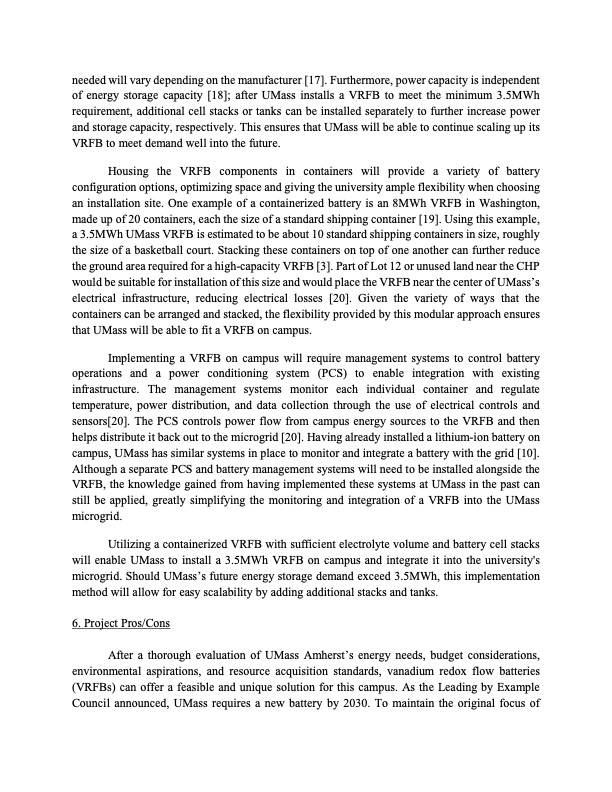
PDF Publication Title:
Text from PDF Page: 006
needed will vary depending on the manufacturer [ of energy storage capacity [18]; a 17]. Furthermore, power capacity is independent fter UMass installs a VRFB to meet the minimum 3.5MWh requirement, additional cell stacks or tanks can be installed separately to further increase power . This ensures that UMass will be able to continue scaling up its VRFB to meet demand well into the future. Housing the VRFB components in containers will provide a variety of battery configuration options, optimizing space and giving the university ample flexibility when choosing an installation site. One example of a containerized battery is an 8MWh VRFB in Washington, made up of 20 containers, each the size of a standard shipping container [19]. Using this example, a 3.5MWh UMass VRFB is estimated to be about 10 standard shipping containers in size, roughly the size of a basketball court. Stacking these containers on top of one another can further reduce the ground area required for a high-capacity VRFB [3]. Part of Lot 12 or unused land near the CHP would be suitable for installation of this size and would place the VRFB near the center of UMass’s electrical infrastructure, reducing electrical losses [20]. Given the variety of ways that the containers can be arranged and stacked, the flexibility provided by this modular approach ensures that UMass will be able to fit a VRFB on campus. Implementing a VRFB on campus will require management systems to control battery operations and a power conditioning system (PCS) to enable integration with existing infrastructure. The management systems monitor each individual container and regulate temperature, power distribution, and data collection through the use of electrical controls and sensors[20]. The PCS controls power flow from campus energy sources to the VRFB and then helps distribute it back out to the microgrid [20]. Having already installed a lithium-ion battery on campus, UMass has similar systems in place to monitor and integrate a battery with the grid [10]. Although a separate PCS and battery management systems will need to be installed alongside the VRFB, the knowledge gained from having implemented these systems at UMass in the past can still be applied, greatly simplifying the monitoring and integration of a VRFB into the UMass microgrid. Utilizing a containerized VRFB with sufficient electrolyte volume and battery cell stacks will enable UMass to install a 3.5MWh VRFB on campus and integrate it into the university's microgrid. Should UMass’s future energy storage demand exceed 3.5MWh, this implementation method will allow for easy scalability by adding additional stacks and tanks. 6. Project Pros/Cons After a thorough evaluation of UMass Amherst’s energy needs, budget considerations, environmental aspirations, and resource acquisition standards, vanadium redox flow batteries (VRFBs) can offer a feasible and unique solution for this campus. As the Leading by Example Council announced, UMass requires a new battery by 2030. To maintain the original focus of and storage capacity, respectivelyPDF Image | Power of Implementing a Vanadium Redox Flow Battery UMass

PDF Search Title:
Power of Implementing a Vanadium Redox Flow Battery UMassOriginal File Name Searched:
vanadiumredoxflowbatteryicons2paper.pdfDIY PDF Search: Google It | Yahoo | Bing
Salgenx Redox Flow Battery Technology: Salt water flow battery technology with low cost and great energy density that can be used for power storage and thermal storage. Let us de-risk your production using our license. Our aqueous flow battery is less cost than Tesla Megapack and available faster. Redox flow battery. No membrane needed like with Vanadium, or Bromine. Salgenx flow battery
| CONTACT TEL: 608-238-6001 Email: greg@salgenx.com | RSS | AMP |